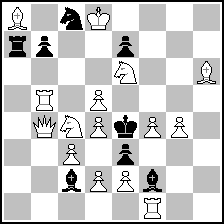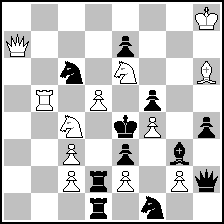|
|
| (1) Posted by David Knezevic [Thursday, Sep 28, 2006 04:04] |
A tough nut!
I just stumbled upon one twomover while surfing on Internet. It has an unpleasant formal flaw (+ one quadruple in non-thematic variation not mentioned in solution below) for which I am not sure that can be avoided, but who knows? I did not try anything and I am immediately passing a 'hot potato' to you.
Warning: this may be a tough nut! Try to recognize the theme and to (re)construct it in a conventional setting if possible. The solution looks literally like this:
1.S:e3? (2.Sc5#), 1... b6!
1.d:e3? (2.Sg5#), 1... Bh4!
1.Q:e7! (2.Qh7#)
1... b5 2.Sc5#
1... Bh4 2.Sg5#
(1... S:e7 2.Sg6#)
|
|
| (2) Posted by David Knezevic [Sunday, Oct 1, 2006 11:45] |
OK, no answers, so new question: Is promoted Ba8 and are the duals after 1... Sd6 avoidable?
Th. Zirkwitz & J. Kuhlmann
6.HM Reiners MT 1990 (= 15+8 ) (= 15+8 )
#2
Solution as in previous post.
|
|
| (3) Posted by Paz Einat [Monday, Oct 2, 2006 00:37] |
There are probably various possibilities but it seems that the scheme can be done by selfblocks instead of line openings. A quick sketch is as follows:
W-Kh8 Qa7 Rb5 Bh6 Sc4 Se6 c2 c3 d5 e2 f4 g2
B-Ke4 Qh7 Rd1 Rd2 Bg6 Sc6 Sf1 e3 e7 f5 h4
1.Qc7? 2.Sg5# 1...B:f4!
1.Qd7? 2.Sc5# 1...R:d5!
1.Q:e7! 2.Sd6#
|
|
| (4) Posted by David Knezevic [Monday, Oct 2, 2006 02:49] |
Some typing errors Paz, I assume this is close to your position:
 (= 12+11 ) (= 12+11 )
Yes this is a correct Dombrovskis, though probably possible in much lighter position. But it seems that authors INSISTED on Somov-I mates! For followers of philosophy of Herbert Ahues (and for some not so faitful followers like myself) there is a huge difference between the line play and other (simpler) effects. I am sure that authors would have never gave up the B-theme!
|
|
| (5) Posted by David Knezevic [Thursday, Oct 5, 2006 13:00]; edited by David Knezevic [06-10-05] |
My conscience started to bother me and I asked myself: was it a sadistic part of my character which made me ask a question like this. Therefore I decided to try it myself, and found out that the answer was not easy, but also not too hard. Didn't need much time, a little over one hour, to reach this position:M. Velimirović
after Th. Zirkwitz & J. Kuhlmann
 (= 14+10 ) (= 14+10 )
#2 vv | 1.Qd1? ~ 2.Se3#
1... Bd2!
1.Qg4? ~ 2.Se7#
1... fe6 2.Be6:#
1... fg6!
1.Qh5! ~ 2.Sg7#
1... Bd2 2.Se3#
1... fg6 2.Se7#
(1... e3 2.Qf3#)
(1... Rh6: 2.Sh6:#) |
The only flaw is a dual in try (1.Qd1 e3 2.Qf3/Qh1) which is not so serious because mate on f3 was already set for 1... e3, and this is a side variation. Anyway, I would have added a WPg2 if it did not lead to an illegal position, while moving WPh4 to g2 would result with a double threat - and that IS a serious flaw!
Why I asked this question? Well, whole my life I had problems with people (not only chess composers) if I dared to warn them that they are not trying enough, that results of their work are not good enough (more often not good at all). The only way to proove it is to do their job instead of them, and it can take weeks, sometimes even months of effort. How much money have been earned by others for my work! Luckilly, in chess problems it is much easier, just one "sixty-minutes-worth-of-distance-run" construction is a sufficient proof.
|
|
| (6) Posted by Hauke Reddmann [Friday, Oct 6, 2006 14:38]; edited by Hauke Reddmann [06-10-06] |
Milan wrote:
"Why I asked this question? Well, whole my life I had problems with people (not only chess composers) if I dared to warn them that they are not trying enough, that results of their work are not good enough (more often not good at all). The only way to proove it is to do their job instead of them, and it can take weeks, sometimes even months of effort. How much money have been earned by others for my work! Luckilly, in chess problems it is much easier, just one "sixty-minutes-worth-of-distance-run" construction is a sufficient proof."
[Ha! We need a quoting gizmo too! :-)]
I know that well, the only difference being that luckily I'm a lightning
fast composer and usually just need hours. If it's a tough one. Just
correcting minor sloppiness I do in a few minutes :-)
Food for thought: There obviously are several economy styles.
Wieland Bruch is about the opposite of numeric economics, but his problems
are so complex that I don't even think about hoping to construct a single
piece away. Herbert Ahues is the personified elegance. There's nothing
unclear about his problems. And I am Wile E. Coyote the trickster, with
a giant bag of creative solutions to seemingly unattainable goals.
Whereas $Normalman seems to compose like he programs: one patch is
stapled above the other until a bunch of epicycles obscur the core.
Hauke
EDIT: Have you tried to use Bc8/Rd7 instead of Bg8/Pf7/Rh7? Might kill
a lot of pawns if it works. Or Bf2->g1 so the dual is in the (irrelevant)
set?
|
|
| (7) Posted by David Knezevic [Friday, Oct 6, 2006 15:30]; edited by David Knezevic [06-10-06] |
EDIT: Have you tried to use Bc8/Rd7 instead of Bg8/Pf7/Rh7? Might kill
a lot of pawns if it works. Or Bf2->g1 so the dual is in the (irrelevant)
set?
Bc8/Rd7 is fine, but not in this case :) - Rd7 always guards the threat on e7
Bg1: cannot find good way to prevent the check Be1+
btw, does "$" prefix mean: bold this word? I've seen other suggestions by you elsewhere, and I'll have them in view for a "real" version. At the moment we use a rather primitive standard HTML input field without rich text possibilities. Of course, one can add a HTML formatting if he knows how to do it, as I did here. I have few more questions for you which I will send in personal note (not to bother other people with "technical" issues)
|
|
| (8) Posted by Hauke Reddmann [Sunday, Oct 8, 2006 15:22] |
R guard - my bad, I took only a glance at the mechanics.
This morning I sat a whole hour trying to improve the
setting - no luck, this is trickier than I expected.
How about changing the matrix itself and moving the
knight two fields away from the black King? Or letting
the solution threat be a guard cut-off such that the
block pawns are avoided? (The mentioned guard of course
must be overloaded with another mate so he can't parry
with a critical move :-)
Hauke
P.S. "$" as in BASIC $ for strings. This is geekspeak;
usage: $ITEM meaning "a generic, unspecified instant
of ITEM".
|
|
| (9) Posted by David Knezevic [Sunday, Oct 8, 2006 16:06] |
Moving the knight two squares away will probably add some breathing space on both sides of the battery line. Looks easier, byt may show opposite. Also, maybe a diagonal battery matrix offers better chances?
Anyway, I was only interested if the authors could have avoided WBa8-BPb7 placing. Bishop can be accepted as obstrusive (replacement for captured original Bishop), but this very constellation detracts the attention so much that it hearts my eyes - and that inevitably and irreparably spoils the impression about the composition. Let alone the quadruple after 1...Sd6 :(((((
|
|
| (10) Posted by Hauke Reddmann [Monday, Oct 9, 2006 11:15] |
Gets even worse (N two fields away) as the Q could
mate in the "breathing space". (I tried.)
Diagonally I'll try next.
Hauke
|
|
| (11) Posted by Hauke Reddmann [Monday, Oct 9, 2006 12:45] |
At least, my interference suggestion (think wNc8,bQb8 instead
of bPd6) seams viable, it's only that at the moment I need more pawns
for all the cooks than I deleted :-)
Hauke
|
|
| (12) Posted by Hauke Reddmann [Monday, Oct 9, 2006 15:46]; edited by Hauke Reddmann [06-10-09] |
And here one for the diagonal setup (the idea with the
guard works as such - but as usual, the guard guards
too much, especially if it's a Reddmann knight - must
somehow have to do with my 2300 ELO :-) - so I went
back to block pawns - but now I also have to jettison
four *black* block pieces to make the parry unique,
so this is just "proof of concept"):
 (= 12+12 ) (= 12+12 )
1.Qe8? Bxf4! 1.Qf8? Rb6! 1.Qh8!
|
|
| (13) Posted by David Knezevic [Monday, Oct 9, 2006 15:54] |
Good for you!
Of course each heavy position is an invitation for improvement attmept...
Will anybody try it? (I am tempted, but don't have time now)
|
|
| (14) Posted by Hauke Reddmann [Tuesday, Oct 10, 2006 16:46] |
I did the improvement :-)
Not exactly material-wise (16+6) - 22 men I can also do in
a slightly done-over version of last diagram -
but I now managed to pep up the tries as such:
1. Qa6? (2.Nf3) Rb5? 2.Nc6# (1...Rf2!)
1. Qd6? (2.Nc6) Rxc5? 2.Nf3# (1...Rb6!)
1. Qf6! (2.Nc4) Rf2/Rb6 2.Nf3/Nc6#
So it's got also an additional Pseudo LeGrand if I
remember noodle soup terminology correctly. :-)
Only blemish: Qa6 gives a flight on e5 (but it's covered).
The four block pawns might as well be removed (then 2.N~).
PM me if you want it for MatPlus.
Hauke
|
|
| (15) Posted by Hauke Reddmann [Tuesday, Oct 17, 2006 12:55] |
EDIT: Have submitted it anyway just to test if the
test version (the forum, not the problem :-) works.
Hauke
|
|
No more posts |
MatPlus.Net  Forum Forum  Promenade Promenade  A tough nut! A tough nut! |
 ISC 2025
ISC 2025 Forum
Forum  Promenade
Promenade  A tough nut!
A tough nut! 


